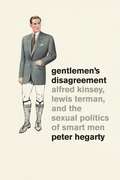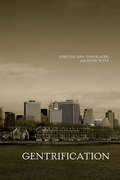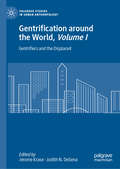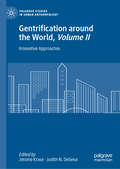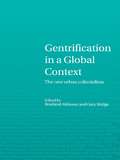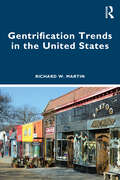- Table View
- List View
Gentlemen's Disagreement: Alfred Kinsey, Lewis Terman, and the Sexual Politics of Smart Men
by Peter HegartyWhat is the relationship between intelligence and sex? In recent decades, studies of the controversial histories of both intelligence testing and of human sexuality in the United States have been increasingly common—and hotly debated. But rarely have the intersections of these histories been examined. In Gentlemen’s Disagreement, Peter Hegarty enters this historical debate by recalling the debate between Lewis Terman—the intellect who championed the testing of intelligence— and pioneering sex researcher Alfred Kinsey, and shows how intelligence and sexuality have interacted in American psychology. Through a fluent discussion of intellectually gifted onanists, unhappily married men, queer geniuses, lonely frontiersmen, religious ascetics, and the two scholars themselves, Hegarty traces the origins of Terman’s complaints about Kinsey’s work to show how the intelligence testing movement was much more concerned with sexuality than we might remember. And, drawing on Foucault, Hegarty reconciles these legendary figures by showing how intelligence and sexuality in early American psychology and sexology were intertwined then and remain so to this day.
Gentlemen's Disagreement: Alfred Kinsey, Lewis Terman, and the Sexual Politics of Smart Men
by Peter HegartyWhat is the relationship between intelligence and sex? In recent decades, studies of the controversial histories of both intelligence testing and of human sexuality in the United States have been increasingly common—and hotly debated. But rarely have the intersections of these histories been examined. In Gentlemen’s Disagreement, Peter Hegarty enters this historical debate by recalling the debate between Lewis Terman—the intellect who championed the testing of intelligence— and pioneering sex researcher Alfred Kinsey, and shows how intelligence and sexuality have interacted in American psychology. Through a fluent discussion of intellectually gifted onanists, unhappily married men, queer geniuses, lonely frontiersmen, religious ascetics, and the two scholars themselves, Hegarty traces the origins of Terman’s complaints about Kinsey’s work to show how the intelligence testing movement was much more concerned with sexuality than we might remember. And, drawing on Foucault, Hegarty reconciles these legendary figures by showing how intelligence and sexuality in early American psychology and sexology were intertwined then and remain so to this day.
Gentrification: Research and Policy on Urban Displacement Processes (essentials)
by Frank EckardtThis essential presents the state of urban research on gentrification in a condensed form. This term, which has been used in the scientific community since the 1960s, has now also become established in the public debate. It describes how rising rents in the cities and the lack of affordable housing lead to poorer residents being driven out of their neighbourhoods. It becomes clear in what way gentrification is a general principle of urban development and thus poses a considerable challenge to the social mix of our cities. It also shows what political measures should be taken from the perspective of research in order to prevent gentrification.This Springer essential is a translation of the original German 1st edition essentials, Gentrifizierung by Frank Eckardt, published by Springer Fachmedien Wiesbaden GmbH, part of Springer Nature in 2018. The translation was done with the help of artificial intelligence (machine translation by the service DeepL.com). A subsequent human revision was done primarily in terms of content, so that the book will read stylistically differently from a conventional translation. Springer Nature works continuously to further the development of tools for the production of books and on the related technologies to support the authors.
Gentrification
by Loretta Lees Tom Slater Elvin WylyThis first textbook on the topic of gentrification is written for upper-level undergraduates in geography, sociology, and planning. The gentrification of urban areas has accelerated across the globe to become a central engine of urban development, and it is a topic that has attracted a great deal of interest in both academia and the popular press. Gentrification presents major theoretical ideas and concepts with case studies, and summaries of the ideas in the book as well as offering ideas for future research.
Gentrification
by Loretta Lees Tom Slater Elvin WylyThis first textbook on the topic of gentrification is written for upper-level undergraduates in geography, sociology, and planning. The gentrification of urban areas has accelerated across the globe to become a central engine of urban development, and it is a topic that has attracted a great deal of interest in both academia and the popular press. Gentrification presents major theoretical ideas and concepts with case studies, and summaries of the ideas in the book as well as offering ideas for future research.
Gentrification: A Working-class Perspective
by Kirsteen PatonFocusing on the working-class experience of gentrification, this book re-examines the enduring relationship between class and the urban. Class is so clearly articulated in the urban, from the housing crisis to the London Riots to the evocation of housing estates as the emblem of ’Broken Britain’. Gentrification is often presented to a moral and market antidote to such urban ills: deeply institutionalised as regeneration and targeted at areas which have suffered from disinvestment or are defined by ’lack’. Gentrification is no longer a peripheral neighbourhood process: it is policy; it is widespread; it is everyday. Yet comparative to this depth and breadth, we know little about what it is like to live with gentrification at the everyday level. Sociological studies have focused on lifestyles of the middle classes and the working-class experience is either omitted or they are assumed to be victims. Hitherto, this is all that has been offered. This book engages with these issues and reconnects class and the urban through an ethnographically detailed analysis of a neighbourhood undergoing gentrification which historicises class formation, critiques policy processes and offers a new sociological insight into gentrification from the perspective of working-class residents. This ethnography of everyday working-class neighbourhood life in the UK serves to challenge denigrated depictions which are used to justify the use of gentrification-based restructuring. By exploring the relationship between urban processes and working-class communities via gentrification, it reveals the ’hidden rewards’ as well as the ’hidden injuries’ of class in post-industrial neighbourhoods. In doing so, it provides a comprehensive ’sociology of gentrification’, revealing not only how gentrification leads to the displacement of the working class in physical terms but how it is actively used within urban policy to culturally displace the working-class subject and traditional
Gentrification and Displacement: The Forced Relocation of Public Housing Tenants in Inner-Sydney (SpringerBriefs in Sociology)
by Alan MorrisThis book examines the forced displacement of public housing residents in Sydney’s Millers Point and The Rocks communities. It considers the strategies deployed by the government to pressure tenants to move, and the social and personal impacts of the displacement on the residents themselves. Drawing on in-depth interviews with tenants alongside government and media communications, the Millers Point case study offers a penetrating and moving analysis of gentrification and displacement in one of Australia’s oldest and more unique working class and public housing neighbourhoods. Gentrification and Displacement advances work in urban studies by charting trends in urban renewal and displacement, furthering our understanding of public housing, gentrification and the effects of forced relocation on vulnerable urban communities.
Gentrification and Resistance: Researching Displacement Processes and Adaption Strategies
by Ilse HelbrechtGentrification is arguably the most dynamic area of conflict in current urban development policy – it is the process by which poorer populations are displaced by more affluent groups. Although gentrification is well-documented, German and international research largely focuses on improvements in the built environment and social composition of neighbourhoods. The consequences for those who are displaced often remain overlooked. Where do they move? What does it mean to be forced to leave a familiar residential area? What kinds of resistance strategies are developed? How does anti-gentrification work? With a focus on Berlin – the German "capital of gentrification" – the chapters in this volume use innovative methods to explore these pressing questions.
Gentrification around the World, Volume I: Gentrifiers and the Displaced (Palgrave Studies in Urban Anthropology)
by Jerome Krase Judith N. DeSenaBringing together scholarly but readable essays on the process of gentrification, this two-volume collection addresses the broad question: In what ways does gentrification affect cities, neighborhoods, and the everyday experiences of ordinary people? In this first volume of Gentrification around the World, contributors from various academic disciplines provide individual case studies on gentrification and displacement from around the globe: chapters cover the United States of America, Spain, Brazil, Sweden, Japan, Korea, Morocco, Great Britain, Canada, France, Finland, Peru, India, Indonesia, Pakistan, Syria, and Iceland. The qualitative methodologies used in each chapter—which emphasize ethnographic, participatory, and visual approaches that interrogate the representation of gentrification in the arts, film, and other mass media—are themselves a unique and pioneering way of studying gentrification and its consequences worldwide.
Gentrification around the World, Volume II: Innovative Approaches (Palgrave Studies in Urban Anthropology)
by Jerome Krase Judith N. DeSenaBringing together scholarly but readable essays on the process of gentrification, this two-volume collection addresses the broad question: In what ways does gentrification affect cities, neighborhoods, and the everyday experiences of ordinary people? In this second volume of Gentrification around the World, contributors contemplate different ways of thinking about gentrification and displacement in the abstract and “on-the-ground.” Chapters examine, among other topics, social class, development, im/migration, housing, race relations, political economy, power dynamics, inequality, displacement, social segregation, homogenization, urban policy, planning, and design. The qualitative methodologies used in each chapter—which emphasize ethnographic, participatory, and visual approaches that interrogate the representation of gentrification in the arts, film, and other mass media—are themselves a unique and pioneering way of studying gentrification and its consequences worldwide.
Gentrification, Displacement, and Alternative Futures
by Erualdo González RomeroGentrification is one of the most debilitating—and least understood—issues in American cities today. Scholars and community activists adjoin in Gentrification, Displacement, and Alternative Futures to engage directly and critically with the issue of gentrification and to address its impacts on marginalized, materially exploited, and displaced communities. Authors in this collection begin to unpack and explore the forces that underlie these significant changes in an area’s social character and spatial landscape. Central in their analyses is an emphasis on racial formations and class relations, as they each look to find the essence of the urban condition through processes of demographic change, economic restructuring, and gentrification. Their original findings locate gentrification within a carefully integrated theoretical and political framework and challenge readers to look critically at the present and future of gentrification studies. Gentrification, Displacement, and Alternative Futures is a vital read for scholars and researchers, as well as planners and organizers hoping to understand the contemporary changes happening in our urban areas.
Gentrification, Displacement, and Alternative Futures
by Erualdo González Romero Michelle E. Zuñ Iga Ashley C. Hernandez Rodolfo D. TorresGentrification is one of the most debilitating—and least understood—issues in American cities today. Scholars and community activists adjoin in Gentrification, Displacement, and Alternative Futures to engage directly and critically with the issue of gentrification and to address its impacts on marginalized, materially exploited, and displaced communities. Authors in this collection begin to unpack and explore the forces that underlie these significant changes in an area’s social character and spatial landscape. Central in their analyses is an emphasis on racial formations and class relations, as they each look to find the essence of the urban condition through processes of demographic change, economic restructuring, and gentrification. Their original findings locate gentrification within a carefully integrated theoretical and political framework and challenge readers to look critically at the present and future of gentrification studies. Gentrification, Displacement, and Alternative Futures is a vital read for scholars and researchers, as well as planners and organizers hoping to understand the contemporary changes happening in our urban areas.
Gentrification in a Global Context: The New Urban Colonialism (Housing and Society Series)
by Rowland Atkinson Gary BridgeGentrification, a process of class neighbourhood upgrading, is being identified in a broader range of urban contexts throughout the world. This book throws new light and evidence to bear on a subject that deeply divides commentators on its worth and social costs given its ability to physically improve areas but also to displace indigenous inhabitants.Gentrification in a Global Perspective brings together the most recent theoretical and empirical research on gentrification at a global scale. Each author gives an overview of gentrification in their country so that each chapter retains a unique approach but tackles a common theme within a shared framework. The main feature of the book is a critical and well-written set of chapters on a process that is currently undergoing a resurgence of interest and one that shows no sign of abating.
Gentrification in a Global Context (Housing and Society Series)
by Rowland Atkinson Gary BridgeGentrification, a process of class neighbourhood upgrading, is being identified in a broader range of urban contexts throughout the world. This book throws new light and evidence to bear on a subject that deeply divides commentators on its worth and social costs given its ability to physically improve areas but also to displace indigenous inhabitants.Gentrification in a Global Perspective brings together the most recent theoretical and empirical research on gentrification at a global scale. Each author gives an overview of gentrification in their country so that each chapter retains a unique approach but tackles a common theme within a shared framework. The main feature of the book is a critical and well-written set of chapters on a process that is currently undergoing a resurgence of interest and one that shows no sign of abating.
Gentrification in Helsinki: Urban Planning at the Edge of the Welfare State (Routledge Research in Planning and Urban Design)
by Kevin DrainThis book unravels the paradox of gentrification in Helsinki, Finland. Here, housing and welfare policies work well under certain conditions to prevent the worst outcomes of residential gentrification. Yet other forms of gentrification have proliferated in recent years, and local urban planning has gained a momentum in efforts to remake the urban landscape for business and tourism.Through a range of methods, each chapter approaches a different aspect of gentrification: the effectiveness of welfare policies against residential gentrification, the importance of retail gentrification and symbolic changes, the role of media and state-led tourism campaigns in promoting gentrification, the rise of vibrancy and sustainability as concepts driving regeneration, and the question of planning principles like participation in confronting gentrification. The reader will find a state system that supports a delicate balance in housing, but a local planning regime related to a more “generalized” gentrification. The results raise questions about the limits of the welfare state in an age of global competition.While new readers of gentrification will benefit from a deep engagement with the literature, the case of Helsinki is relevant to all students of planning, social sciences, and urban studies, as well as professionals in related fields.
Gentrification in Helsinki: Urban Planning at the Edge of the Welfare State (Routledge Research in Planning and Urban Design)
by Kevin DrainThis book unravels the paradox of gentrification in Helsinki, Finland. Here, housing and welfare policies work well under certain conditions to prevent the worst outcomes of residential gentrification. Yet other forms of gentrification have proliferated in recent years, and local urban planning has gained a momentum in efforts to remake the urban landscape for business and tourism.Through a range of methods, each chapter approaches a different aspect of gentrification: the effectiveness of welfare policies against residential gentrification, the importance of retail gentrification and symbolic changes, the role of media and state-led tourism campaigns in promoting gentrification, the rise of vibrancy and sustainability as concepts driving regeneration, and the question of planning principles like participation in confronting gentrification. The reader will find a state system that supports a delicate balance in housing, but a local planning regime related to a more “generalized” gentrification. The results raise questions about the limits of the welfare state in an age of global competition.While new readers of gentrification will benefit from a deep engagement with the literature, the case of Helsinki is relevant to all students of planning, social sciences, and urban studies, as well as professionals in related fields.
Gentrification Of The City (Routledge Library Editions: The City)
by Neil Smith Peter WilliamsThis book was first published in 1986.
The Gentrification of Queer Activism: Diversity Politics and the Promise of Inclusion in London
by Olimpia BurchiellaroIn the 2010s, London’s LGBTQ+ scene was hit by extensive venue closures. For some, this represented the increased inclusion of LGBTQ+ people in society. For others, it threatened the city’s status as a ‘global beacon of diversity’ or merely reaffirmed the hostility of London’s neoliberal landscapes. Navigating these competing realities, Olimpia Burchiellaro explores the queer politics of LGBTQ+ inclusion in London. Drawing on ethnographic research conducted with activists, professionals and LGBTQ-friendly businesses, the author reveals how gender and sexuality come to be reconfigured in the production and consumption of LGBTQ+ inclusion and its promises. Giving voice to queer perspectives on inclusion, this is an important contribution to our understanding of urban policy, nightlife, neoliberalism and LGBTQ+ politics.
The Gentrification of Queer Activism: Diversity Politics and the Promise of Inclusion in London
by Olimpia BurchiellaroIn the 2010s, London’s LGBTQ+ scene was hit by extensive venue closures. For some, this represented the increased inclusion of LGBTQ+ people in society. For others, it threatened the city’s status as a ‘global beacon of diversity’ or merely reaffirmed the hostility of London’s neoliberal landscapes. Navigating these competing realities, Olimpia Burchiellaro explores the queer politics of LGBTQ+ inclusion in London. Drawing on ethnographic research conducted with activists, professionals and LGBTQ-friendly businesses, the author reveals how gender and sexuality come to be reconfigured in the production and consumption of LGBTQ+ inclusion and its promises. Giving voice to queer perspectives on inclusion, this is an important contribution to our understanding of urban policy, nightlife, neoliberalism and LGBTQ+ politics.
Gentrification Trends in the United States
by Richard W. MartinGentrification Trends in the United States is the first book to quantify the changes that take place when a neighborhood’s income level, educational attainment, or occupational makeup outpace the city as a whole – the much-debated yet poorly understood phenomenon of gentrification. Applying a novel method to four decades of U.S. Census data, this resource for students and scholars provides a quantitative basis for the nuanced demographic trends uncovered through ethnography and other forms of qualitative research. This analysis of a rich data source characterized by a broad regional and chronological scope provides new insight into larger questions about the nature and prevalence of gentrification across the United States. Has gentrification become more common over time? Which cities have experienced the most gentrification? Is gentrification widespread, or does it tend to be concentrated in a small number of cities? Has the nature of gentrification changed over time? Ideal reading for courses in real estate, urban planning, urban economics, sociology, geography, econometrics, and GIS, this pathbreaking addition to the urban studies literature will enrich the perspective of any scholar of U.S. cities.
Gentrification Trends in the United States
by Richard W. MartinGentrification Trends in the United States is the first book to quantify the changes that take place when a neighborhood’s income level, educational attainment, or occupational makeup outpace the city as a whole – the much-debated yet poorly understood phenomenon of gentrification. Applying a novel method to four decades of U.S. Census data, this resource for students and scholars provides a quantitative basis for the nuanced demographic trends uncovered through ethnography and other forms of qualitative research. This analysis of a rich data source characterized by a broad regional and chronological scope provides new insight into larger questions about the nature and prevalence of gentrification across the United States. Has gentrification become more common over time? Which cities have experienced the most gentrification? Is gentrification widespread, or does it tend to be concentrated in a small number of cities? Has the nature of gentrification changed over time? Ideal reading for courses in real estate, urban planning, urban economics, sociology, geography, econometrics, and GIS, this pathbreaking addition to the urban studies literature will enrich the perspective of any scholar of U.S. cities.
Gentrification: A Working-Class Perspective
by Kirsteen PatonFocusing on the working-class experience of gentrification, this book re-examines the enduring relationship between class and the urban. Class is so clearly articulated in the urban, from the housing crisis to the London Riots to the evocation of housing estates as the emblem of ’Broken Britain’. Gentrification is often presented to a moral and market antidote to such urban ills: deeply institutionalised as regeneration and targeted at areas which have suffered from disinvestment or are defined by ’lack’. Gentrification is no longer a peripheral neighbourhood process: it is policy; it is widespread; it is everyday. Yet comparative to this depth and breadth, we know little about what it is like to live with gentrification at the everyday level. Sociological studies have focused on lifestyles of the middle classes and the working-class experience is either omitted or they are assumed to be victims. Hitherto, this is all that has been offered. This book engages with these issues and reconnects class and the urban through an ethnographically detailed analysis of a neighbourhood undergoing gentrification which historicises class formation, critiques policy processes and offers a new sociological insight into gentrification from the perspective of working-class residents. This ethnography of everyday working-class neighbourhood life in the UK serves to challenge denigrated depictions which are used to justify the use of gentrification-based restructuring. By exploring the relationship between urban processes and working-class communities via gentrification, it reveals the ’hidden rewards’ as well as the ’hidden injuries’ of class in post-industrial neighbourhoods. In doing so, it provides a comprehensive ’sociology of gentrification’, revealing not only how gentrification leads to the displacement of the working class in physical terms but how it is actively used within urban policy to culturally displace the working-class subject and traditional
Gentrifications: Views from Europe (Anthropology of Europe #7)
by Lydie Launay Marie Chabrol Anaïs Collet Matthieu GiroudOffering an original discussion of the gentrification phenomenon in Europe, this book provides new theoretical insights into classical works on the subject. Using a thorough analysis of the diversity of the forms, places and actors of gentrification in an attempt to isolate its ‘DNA’, the book addresses the place of social groups in cities, their competition over the appropriation of space, the infrastructure unequally offered to them by economic and political actors and the stakes of everyday social relationships.
Gentrifications: Views from Europe (Anthropology of Europe #7)
by Lydie Launay Marie Chabrol Anaïs Collet Matthieu GiroudOffering an original discussion of the gentrification phenomenon in Europe, this book provides new theoretical insights into classical works on the subject. Using a thorough analysis of the diversity of the forms, places and actors of gentrification in an attempt to isolate its ‘DNA’, the book addresses the place of social groups in cities, their competition over the appropriation of space, the infrastructure unequally offered to them by economic and political actors and the stakes of everyday social relationships.
